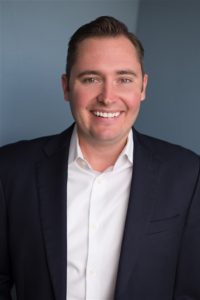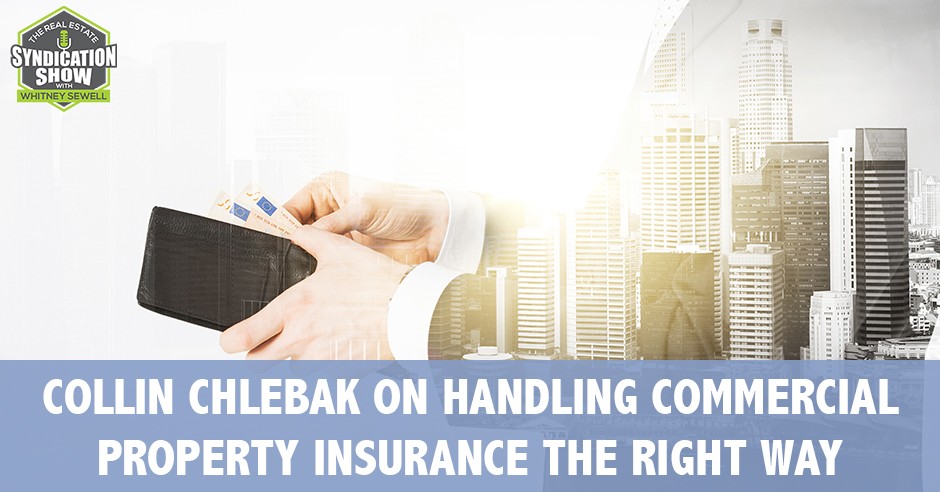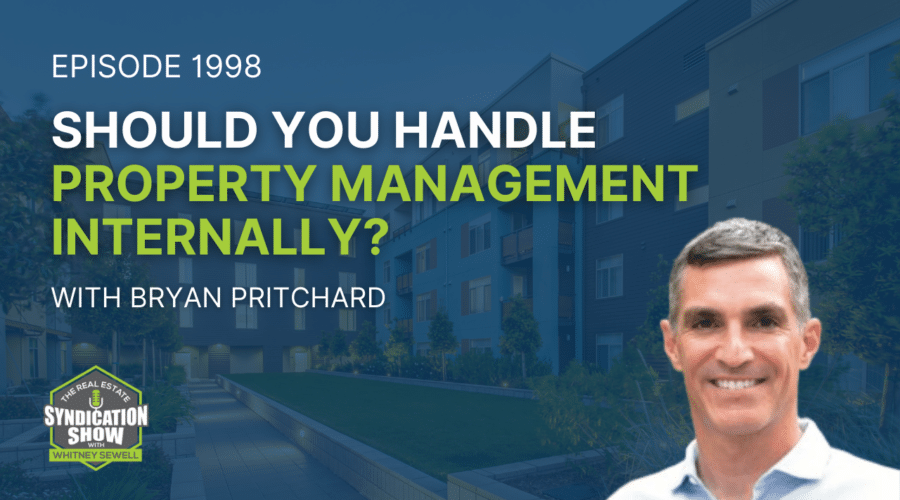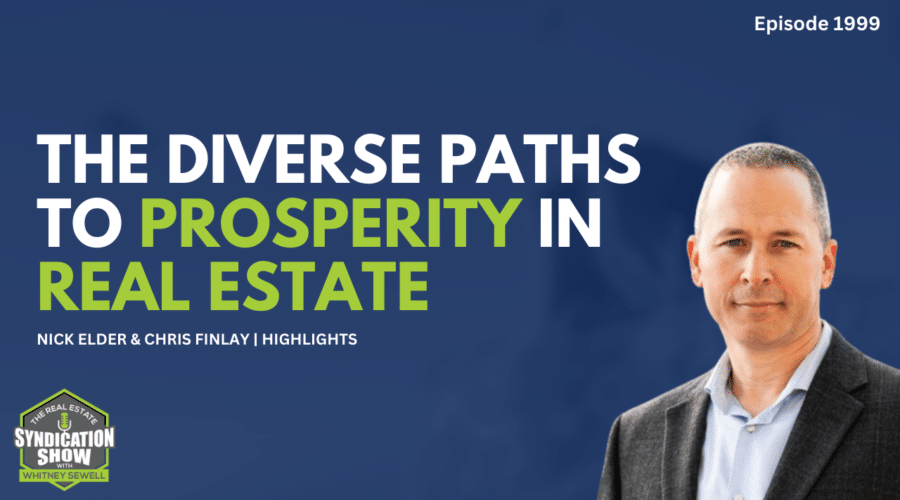Listen to the podcast here:
Collin Chlebak, the Vice President of Virtus, talks about how to approach commercial property insurance as a broker and how to handle clients efficiently. Virtus is a financial planning firm that touches over 300,000 multifamily units and over 100 million square feet of commercial real estate. Collin provides hands-on insurance consultations and brokered services to owners, operators, and developers of multifamily and commercial real estate across the country. He dives into the subject of insurance, pre-funds, talking to an insurance broker, and some key things that we need to make sure our brokers are doing. As Collin walks us through the process of getting a quote, he also gives a good rule of thumb that to use when syndicators are underwriting opportunities or deals.
Our Gracious Sponsor:
Are you wanting to learn how to gain financial freedom through having your own syndication business? Text LEARN to 474747 to begin to learn from one of the best in the industry, Vinney Chopra. Vinney came to the US with only $7 in his pocket, and now controls hundreds of millions of dollars of real estate he has acquired through multifamily syndication. He is now personally coaching others to do the same. Text LEARN to 474747 to begin your journey to starting your own syndication business! Vinneychopra.com
—
Watch the episode here:
Collin Chlebak on Handling Commercial Property Insurance The Right Way
Our guest is Collin Chlebak. Thanks for being on the show, Collin.
Thanks for having me. I’m excited about it.
Collin is the Vice President of Virtus in a production role in 2015 and he leads Virtus National Real Estate Practice that touches over 300,000 multifamily units and 100 million-plus square feet of commercial real estate. He provides hands-on insurance consultations and brokered services to owners, operators and developers of multifamily and commercial real estate across the country. He delivers customized insurance strategies to achieve the business goals of industry firms. His passion for real estate ignited after being a witness to significant commercial infrastructure and residential transactions during his time managing the District Office for a member of the US Congress. Collin, tell the audience a little more about who you are and let’s dive into this subject of insurance.
My dad was in insurance and he told me to go in insurance right out of school. Being a young adult, he told me to do that. I didn’t do it of course, and then found my way here. I have a passion for real estate that I always liked building things, seeing things being built around town, redevelopment and all that stuff. When I decided that I was not going to continue a career in politics, I said I’m going to either do commercial real estate or insurance because those are two things that I had a lot of interest in. The transition to insurance was just more of a natural one with growing up around it. I’ve been with Virtus for a few years. The firm has only been around for a few years. When we started, I was employee number five and now we’ve got over 50 in two offices and trying to grow some more. It’s been a fun couple of years here.
Insurance is obviously a very important topic. When we’re talking about buying a large commercial building of any kind, there are many ways we could take that. This is the importance of having proper insurance. I was hoping maybe you could get us started in some things we should be thinking about when we’re looking at commercial property. Maybe we can talk about the property specifics, but even when we’re talking to an insurance broker, some things we need to keep in mind from one broker to another.
[bctt tweet=”Learning about clients and prospects in the front end creates a harmonious relationship with them.” via=”no”]
There are a ton of different ways that people approach insurance or can approach insurance. Having open, transparent dialogue with a broker is the foundation. We talk a lot about one of our expertise in the space and how many deals that we looked at and are involved in. Out of the 300,000 doors that we insure in the multifamily space, no two clients approach insurance the same. There will be people that will have a very small risk appetite from a deductible exposure. Maybe they’d rather pay more up front and premium and just know that they’re not going to have to go out of pocket more than $10,000 for the deductible if a claim occurs.
We have people who look at the entire opposite of the spectrum there and say, “We’ll take a deductible of $500,000.” We want to make sure that our annual cost is as low as it can be and we’d rather pre-fund and do some things to participate in the risk as opposed to letting the insurance carriers profit. I always think it starts with a very transparent dialogue between your broker and maybe interviewing several brokers to make sure that you get that experience. Making sure they have an expertise in the space, whether it be in multifamily, hotels, single-family or mobile homes to make sure they understand how insurance works in your space or in your vertical. In my mind, it’s not just a quote. What are the goals? What are we trying to achieve out of our insurance? We like to learn a lot about our clients and our prospects on the front end so that we have a real harmonious relationship and there are no surprises on either end. Nobody wants to have an insurance call, a claim scenario or maybe call in the middle of the night and be surprised what’s in the policy or what’s not in the policy.
The deductible could be $10,000 and it could be $500,000. Can you give us an example of a client who might use a $10,000 as opposed to a $500,000 and why just to help us gauge what we should be thinking about there if I’m contemplating how big my deductible should be?
We have owners and clients that we deal with all over the spectrum as well. I’m working on a 25-unit townhome acquisition for a guy in Lawrence, Kansas. I’m working on a 200-plus-unit deal in Colorado Springs that you’re familiar with. I’m working all over the country. I’ve got clients that have thousands of units or this is their first deal. In general, the smaller deals are where people have more comfort with that smaller deductible. Maybe it’s their first year or maybe they’ve only got a couple. When you start growing some economies of scale, what you can do on the insurance perspective is also benefit from that. If you’ve got 500 units, can you consolidate from five one-off policies to one property policy, one general liability policy and one umbrella policy? The carriers see more premium across your portfolio. It’s some economies of scale. With that, depending on how the syndication is done either on a deal by deal basis or a fun basis, there’s sometimes a little bit more appetite for higher risk. The smaller under 100-unit deals or people who might have just one, two or three assets take a lower deductible. As their business and their portfolio start to evolve, we see the ability to go up on that deductible threshold.
As far as if we have numerous properties and we wanted to be able to carry that across maybe numerous properties, what if they’re in different locations across the country? Do they need to be in the same location or does it matter?

No, it doesn’t. You need to have a mutually insurable tie. In the syndication world, you know this better than me. Everybody sets up a special purpose entity like an LLC or LP or something to acquire one asset so you need more of an umbrella, whether it’s a property management firm or an asset management firm. If you and I were going to start one, we’d say, “Collin and Whitney Management LLC.” That would be the first name insured and would give us the ability to add on other assets to get those economies of scale. It doesn’t matter from a geographic standpoint to add properties together for insurance. Each geographic footprint has its own hurdles in the Gulf. Florida, Texas and Alabama might have their own hurdles because of the likelihood or possibility of a hurricane coming to hit it. Arizona doesn’t have hardly any perils. Wind/hail in the Midwest and in Texas has been big and fires out west, all these things the carriers take a look at when they’re pricing. Your broker, if he’s got the expertise, should be able to say, “We’re going to package our Florida stuff with our Arizona stuff. Maybe on the front end, it looks like Arizona is subsidizing Florida, but we’re driving down the cost holistically.” That’s just one of the scenarios that when you get into it and you’ve got a portfolio, you’ve got to take a look and see how many different ways you can skin the cat.
Some people are pre-fund. What does that mean?
We take a holistic approach to it. We don’t want to be one of the insurance guys that says, “You need to buy X, Y, Z.” We’re not the ones who say, “You need to have this deductible.” We want you to make an educated decision based off of what exposures you have. If there’s a way to approach insurance differently and maybe compress the annual costs, but pre-fund for some of the added deductibles exposure that you’re taking on in a $100,000 or $500,000 deductible range. Can we pre-fund for some of that and create this insulating layer of risk where you’re taking on more exposure, you’re taking the benefit of the lower premium, but you’re also creating this rainy day fund for winter occurrence or a claim scenario that might pop up?
Who’s going to be the client for that?
It’s across the board. The larger portfolios have the ability just from sheer size to do that. Many times the larger the portfolio, the higher the loss that grows with it as well. It’s different in every scenario. We’ve done it for clients in the 5,000 to 10,000-unit space. I’ve done it for a client that has under 1,000 units. They’ll do it for different reasons. One of the scenarios I always say is the guy had roughly 1,000 units spread across Kansas, Missouri, Oklahoma and Arkansas in the LIHTC space Tax Credit section 42 properties. It doesn’t have the ability to raise his rent still to compensate for his growing expenses. He was getting pressed and insurance rates were rising a couple of years back and he said, “I’ve got to figure out a way where I can let myself breathe a little bit more. I can’t raise rents to compensate.” What we did was we looked at it a couple of different ways. What we found is the way he was buying insurance, he had an efficient rate. We could have maybe made a marketing effort and shaved a marginal amount for $1,000 to $2,000 out of his annual spin, but what we saw is if we increased his deductible from $10,000 to $50,000, we would get over $55,000 in savings annually.
[bctt tweet=”It is necessary to have an educated decision based on the risks and exposures a client has.” via=”no”]
That’s a no-brainer but then you say, “In one scenario, I’m back to where I started.” What we did for him getting into this pre-funding discussion is we looked at his loss history from how his assets had performed over the previous few years. Had we rolled out this program a few years prior, he would have been in the black by close to $200,000. There would have been one year where he would have assessed and taken on an additional expense for added claims. It just made sense for him. We allocated additional premium out to create a deductible reserve fund. In year one, we allocated out $40,000 in additional premium that created that initial fund. If there had been a wind/hail occurrence or some occurrence that would have transpired, his insurance would have responded the exact same. Had there been two, then he would have been upside down $40,000. It’s been a few years and he hasn’t had a claim yet. Now he’s sitting there and he’s got $180,000 in the bank that he would have paid directly to the insurance carrier in premium had he been approaching insurance the other way. That’s one example. It’s more of the middle market or small to mid-size portfolios that are in our bread and butter sweet spot. I’m not saying anybody should rush into that, but it’s an example of ways we try to take a different approach and different look to the plays in insurance.
That’s why we need an expert like you. I’m not going to know that without talking to you going through specific scenarios and our specific situation before you would figure that out. Help somebody interview a broker talking about do they have the expertise in your space. What are some other key things that we need to make sure our brokers are doing that or know things that maybe we wouldn’t even know to ask them or to check on ahead of time?
Buying commercial insurance is a different buying experience. It’s a different setup unlike any other buying scenario. I wear a button-down shirt every day. Typically, I only wear blue or white. There are many different options for a blue and white button-down shirt, the fit, this and that. In insurance, if you have a broker who doesn’t dictate pricing, we’re not setting the market. We’re just going out and we’re trying to leverage the best deal and the best coverage on behalf of you. If you’re creating competition between brokers, it’s the first to market wins. If I’m your broker and I go out to the entirety of the market, then I’ve blocked everybody else like my colleagues or competitors to do the same. If you say you’ll quote it, you’re creating some confusion in the market and the underwriters don’t know who they’d be talking to. The best pricing and coverage is difficult to see with multiple brokers out there.
I always say interview a broker on the front end before you let them go to the market and say, “How do you approach things? How do you think about things? What do you honestly think about my portfolio? Where is the pricing? How is the coverage structured?” What we do is we engage in a due diligence audit many times if it’s an existing portfolio or something. We’ll take a look at what you have in place from pricing, coverage, administrative fees. We look at all those different areas and we say, “We liked the coverage here. The pricing is efficient here. It’s under market here. It’s over the market here. Total pollution is excluded.” Those are the questions that we get back.
In total pollution, it’s an exclusion that carriers throw on policies many times to limit their exposure and push it back on you. At the end of the day, it’s something that can be placed a carve back for HVAC. We’re talking about carbon monoxide here. If you’ve got a value-add multifamily asset that’s got maybe some old heating AC or even new heating AC and carbon monoxide, there becomes a carbon monoxide client. If you’ve got that total pollution exclusion, you’re self-insuring that risk. We’ve seen claims that can jump in the millions to $10 million range for carbon monoxide. It’s something easy that your broker should just request a carve back for hostile fires and HVAC so that your coverage does respond as you think it would. The total pollution they’re trying to limit are your asbestos, your lead, things like that. They know the game. The carriers know the game and they’ll try to limit their exposure and pass that on to you.

Sometimes brokers do it on purpose to cut some savings into the policy, and that’s fine if you’re willing to take on that risk. That one is an easy one that should never be on there. It’s just like the deductible conversation. If you’re making a discussion of you know how your policy is going to respond and you’re making active decisions and educated transparent decisions to take on higher exposure and lower your annual costs, that’s fine. You need to be walking into it eyes wide open and understand what decisions you’re making. You don’t want somebody to be dictating those decisions on your behalf.
Could you walk us through the process of maybe getting a quote or maybe we approach somebody like yourself and we’re trying to get a quote? What are maybe some timelines of how long we should expect that to take? What’s going to make that change? When we say, “Collin, we’re doing this deal. We want to use you all.” How close should we expect the actual price to be and what would make a change?
We pride ourselves on having very good internal analytics with such a big focus in this space. We can look at a deal and say, “Do you have lender requirements as what your lender is going to require for the replacement costs to be? Do you agree with that? We can run Marshall & Swift to help figure out the replacement costs of what the coverage should be. That in itself can dictate pricing a little bit, but we can tell you some of the base rates.” The actuality of it is that the commercial frame habitational property rates have increased year-over-year. Since 2017 summer-fall of Harvey, Irma and Maria in 2017, we’ve seen ticks increasing. If you’re acquiring properties that have had losses or your properties have had losses, we see increases. The process is we’ll take a look at the asset. Let’s say this is an acquisition. Let’s just walk through, “We’ve got this new acquisition we’re trying to acquire. We don’t have anything else. This is our first deal. Our investment partners are different from other things so there are no mutual insurable interests. We’re going to approach this on a one-off.
We’d take a look at it very quickly from the OM and create some statement of values. We subscribe to a lot of property databases to help pull some of that data to make it a little bit easier on yourself. We say, “Here’s what we think we have here. Has the seller provided you lost runs?” “No, they haven’t,” or “Yes, they have,” is going to fluctuate. If they have, we’re going to need to see three to five years carriers. You’re going to want to see three to five years. We’ll take that and we’ll say, “In this geographic footprint, this is what market rate is for the standard.” In Texas, deductibles are being pushed higher and higher. Midwest or moving out West is not. Arizona is a much lower deductible. We say, “Here’s what the market is in this range. This is typically a $0.05 range or something. Here’s where decisions you can make can affect that.” If you need to say, “We underwrote. What are our options here?” Maybe we’ll take the Marshall & Swift replacement costs and your lenders say, “We can carve $3 million out of that or something like that.”
We can go through different scenarios once we have it. The whole process in a rush can do it in ten days. We like to have as much time as possible so that you’re making truly educated, transparent decisions. We’d like to have a 30-day window for an acquisition. Let’s say this was an acquisition. You have some economies of scale and you have a portfolio of 1,000 or 2,000 units. Maybe we’ve already built a master insurance program for your portfolio, then it becomes very simple. We can say, “Here’s what it is as long as it doesn’t have any red flags that we’d already discussed with you. If you’re doing B and C value-add in the Southwest or something, as long as it doesn’t have maybe coastal exposures or something like that, we’d have it written in so that you could add it to that program for the policy rate.” If your insurance program ran from seven one to seven one and you acquire something on ten one, then you’re only get paid for the first nine months that it sits on the policy. That can be turned around within the day now that we’re underwriting criteria and stuff like that the carriers are wanting to see, but to give you that indication is very quick. We can streamline the process from an administrative standpoint if you do grow those economies of scale.
[bctt tweet=”You need to have your eyes wide open and understand your decisions.” via=”no”]
When we’re underwriting properties, we’re looking at lots of properties before we find that one that we decided we want to pursue. You and I aren’t going to go through every property. It would waste so much of your time just to get an exact dollar figure. We never get to the second step of pursuing an actual deal until we’ve analyzed 100 or 200 or whatever that number may be. Is there a good rule of thumb that you would suggest when we’re looking at these properties? I know it’s going to vary. There are so many different things that could make that change, but maybe a good rule of thumb that you suggest we use when syndicators are underwriting opportunities or deals to make sure we have it as close as we can on that figure.
If you’ve got a baseline established of what you do or your niche within the industry, it becomes a little bit easier because then it’s like, “We do stuff only in Texas or only in Florida or Arizona or whatnot.” We can say, “Here’s what you need to consider for this area.” If you are operating all across the country, we provide our clients sometimes with a heat map. Anywhere from the coast, you’re going to have to take on higher deductible exposure for name storm, which would be your hurricanes, your Harvey, Irma, Maria and so forth. In the Midwest, you’re going to have exposures from your wind/hail, which is your big concern there. You just need to look at that.
You need to understand if your costs are going to increase, if the history of the asset has a lost history. I always explain it to people as a credit score. The property itself or their loss history is that credit score and it’s going to stick with that asset, not the ownership. Even though you’re acquiring something that happened under other owner’s watch, that asset is going to be stuck with it for carriers. You’re going to want to see how to perform from the past few years. That’s something to be mindful of. Some carriers like student housing, for instance and some despise it. Any difference that is included that might be different from what you’re used to might affect the insurance. We like to have those conversations on the front end and set you up with some red flags that will change insurance from what you’re used to.
There are so many different ways that we can approach this and have a rule of thumb. Initially, somebody should call you and discuss like, “We’re looking at properties in Dallas or in Birmingham or Jacksonville.”
We’ve got clients that will get into new markets and maybe they’ll have something in Georgia. They’ll say, “We found this tertiary market in Kentucky or Tennessee. Before we start looking at deals, we want to know if there’s anything we should be aware of.” That’s typically the best time just to have a quick candid conversation and review some of those things. In general, the newer the update of the asset or the newer the asset, the better the insurance. Things that carriers like are fire sprinklers and safety provisions. The things that they don’t like are things that are going to make an asset cheaper like the aluminum wiring or older breaker boxes and things like that. When they see that, then they see that there’s a likelihood of a claim here. When they’re underwriting it, they’re going to underwrite more premium into it.

You said to contact you about a location or some type of market and ask, “Are there things in this market that we need to be aware of while we’re doing our underwriting or before we start looking at this market?” Collin, you’ve been a great guest and you’ve provided some great insights on insurance and some things we need to talk about and finding that broker that we want to work with and getting quotes. Tell the audience how they can learn more about you and get in touch with you.
I’d love to speak with all of your audience. I’m on LinkedIn, Collin Chlebak is my name. Virtus is our firm. We’re located here in Kansas City, but I am traveling once a week in different markets. We’d love to buy you a cup of coffee or just meet and learn a little bit more about your audience. You can call the office here. You can call my cell phone and that’s (214) 326-8284. You can find us on LinkedIn and our website is VirtusInsurance.com and we’d love to have a conversation.
Collin, thank you so much. I appreciate you putting out the information. Not everybody puts out their cell phone. I hope the audience will reach out to Collin. I hope you’ll also go to Life Bridge Capital and connect with me. Go to our Facebook group, The Real Estate Syndication Show so we can all learn from experts like Collin and ask those questions. I hope you’re sharing the show. We will talk to the audience again next time.
Thank you very much. Have a great day.
Important Links:
- Virtus
- Collin Chlebak on LinkedIn
- LinkedIn – Virtus, LLC
- VirtusInsurance.com
- The Real Estate Syndication Show on Facebook
About Collin Chlebak

Collin provides hands-on insurance consultation and brokerage services to owners, operators and developers of multifamily and commercial real estate across the country. He takes pride in delivering customized insurance strategies to achieve the business goals of industry leading firms.
Before joining Virtus, Collin worked with both elected officials and business executives to solve challenging problems in Dallas, TX. His passion for real estate ignited after being a witness to significant commercial, infrastructure, and residential transactions during his time managing the District Office for a member of the U.S. Congress.
Collin earned a Bachelor of Arts in Political Science from the University of Kansas.
Collin’s hobbies include sports, traveling with his wife, Madison and spending time as a family with their two young boys.
Love the show? Subscribe, rate, review, and share!
Join the Real Estate Syndication Show Community:



